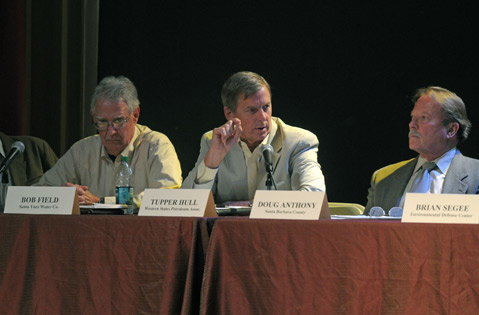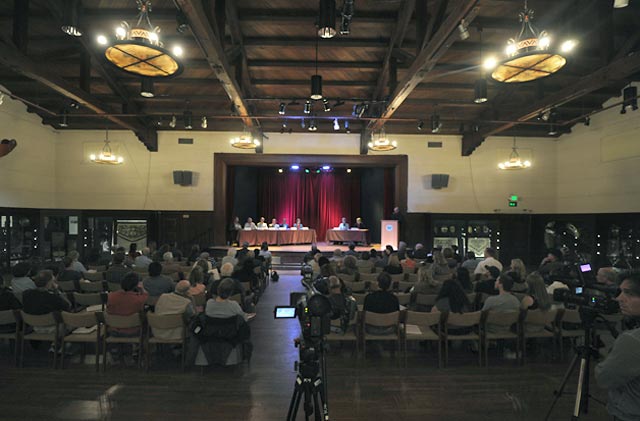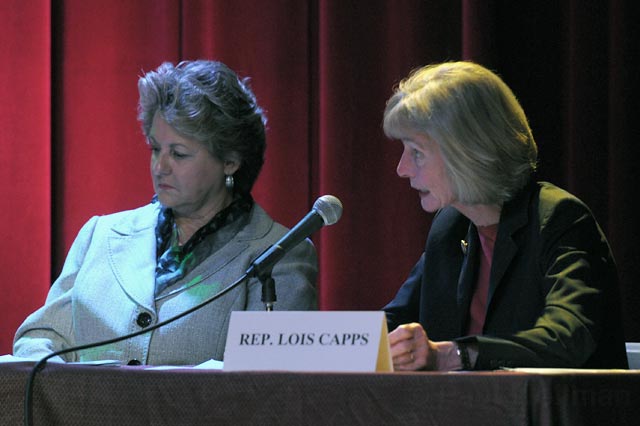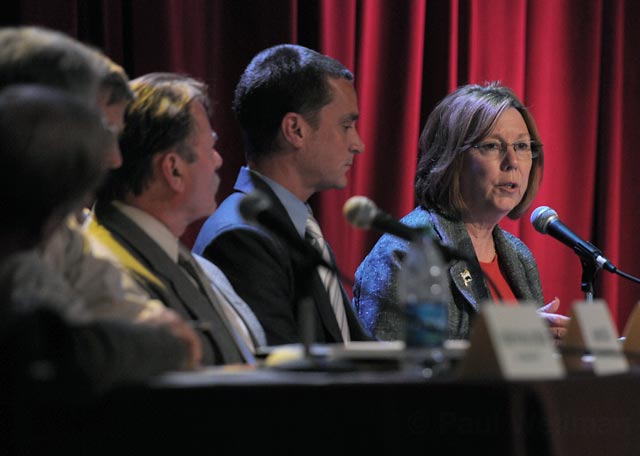Fracking Friction
Panelists, Electeds Talk Law and Oversight

Representative Lois Capps and 3rd District Supervisor Doreen Farr — who, like their constituents, were shaken by the recent discovery that Venoco Inc. is “fracking” on a Los Alamos drilling lease — held a forum last week to discuss the divisive oil-and-gas extraction method and what’s being done to patch the ratty tapestry of legal framework now in place to regulate it.
Their concern, echoed by many of the invited panelists and the attendees who packed the Museum of Natural History’s auditorium, centers on what impacts fracking may have on the health of the North County community’s aquifers, ecosystems, and people. Fracking — short for hydraulic fracturing — is the process by which energy companies inject a pressurized chemical fluid into an existing wellbore, cracking the surrounding rock to harvest as much oil or natural gas from the site as possible. It’s a technique used since the 1940s, and 90 percent of the country’s current wells have been fracked at least once.

But panelist Brian Segee, Environmental Defense Center staff attorney, noted that the chemical concoctions employed today are much different compared to those used in decades past, and fracking technology overall is now an entirely different beast. Because of how current regulatory legislation is crafted, he went on, energy companies are not required to disclose what ingredients they use in their fracking fluid.
In a bid to make companies divulge what’s in their brews, Capps recently cosponsored a bill called the Fracturing Responsibility and Awareness Chemicals Act (FRAC Act) that would take away hydraulic fracturing’s exemption from the Safe Drinking Water Act. Accusing the Bush administration of “coddling” the energy industry to an improper degree, she explained the bill would close the “Halliburton loophole,” so named because it was inserted into a 2005 energy bill at the direction of former vice president Dick Cheney, a onetime chief executive of Halliburton, which invented hydraulic fracturing.
Tupper Hull with the Western States Petroleum Association said the energy companies he represents are all for disclosure as long as it doesn’t expose trade secrets. Western States even supported a state bill that increases California’s regulatory power, he explained, lamenting it’s since been stalled in committee, but claiming there is already “robust” oversight in place.

It’s important to retain a level of competition among companies, which could be compromised if the chemicals they use and in what amounts are made public, Tupper said. As for fracking overall, he stated, there is a lot of confusion and misinformation surrounding the drilling method, calling it a “breathtaking improvement toward a more energy-independent future.”
In response, Bob Field, president of the Santa Ynez Rancho Estate Mutual Water Company, said he doesn’t need to know how much of each chemical is being used when he conducts water tests, but simply what chemicals may be floating in the drinking supply he watches. Condemning the fracking practice in its entirety, Field struck out at what he sees as a deplorable lack of supervision. “If it’s not lawful for a chemical to be in the groundwater, why is it lawful to inject it into the ground?” he asked. Field also took issue with a defense commonly employed by energy companies that only one percent of fracking fluid contains chemicals, the rest being water.
When each Los Alamos hydraulic fracture uses 100,000 gallons of water (there’s been only one frack conducted, said Segee), that’s still 1,000 gallons of chemicals, said Fields. One gallon of contaminated fluid is enough to ruin hundreds of thousands of gallons of drinking water, he explained. Lastly, he noted that all of the water used for the Los Alamos frack came from the area’s aquifer, the only source of drinking water for the town. If the aquifer is compromised, said panelist and Los Alamos resident Chris Wrather, that’d be “game over” for area residents.

State’s Marni Weber with the Department of Oil, Gas and Geothermal Resources (DOGGR) said her agency has the authority to regulate fracking, but lacks the necessary funding and resources to do so. She explained there is a way for companies to voluntarily reveal where they’re fracking (fracfocus.org), but the avenue has seen limited participation. A search of the Web site shows no matches for Santa Barbara County.
Addressing how Santa Barbara is moving forward to ensure drilling leases aren’t fracked again without anyone knowing, Doug Anthony, deputy director of the county’s Energy Division, said a new application process is in the works that would require energy companies looking to frack to go through a public hearing, environmental review, and get approval from the Planning Commission. The Board of Supervisors would hear an appeal if one is made.
On September 20, the supervisors will revisit a potential moratorium on fracking until more definitive regulations can be hammered out. If they do go ahead with a suspension, the county will be the first in the state to do so.



